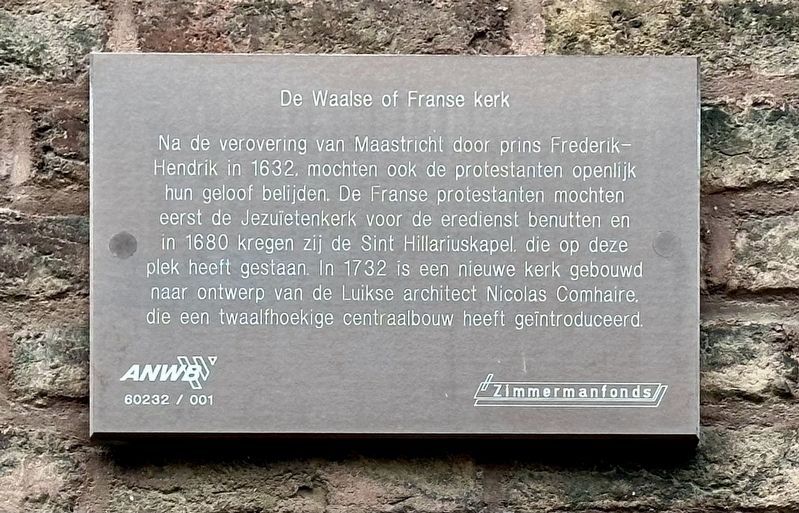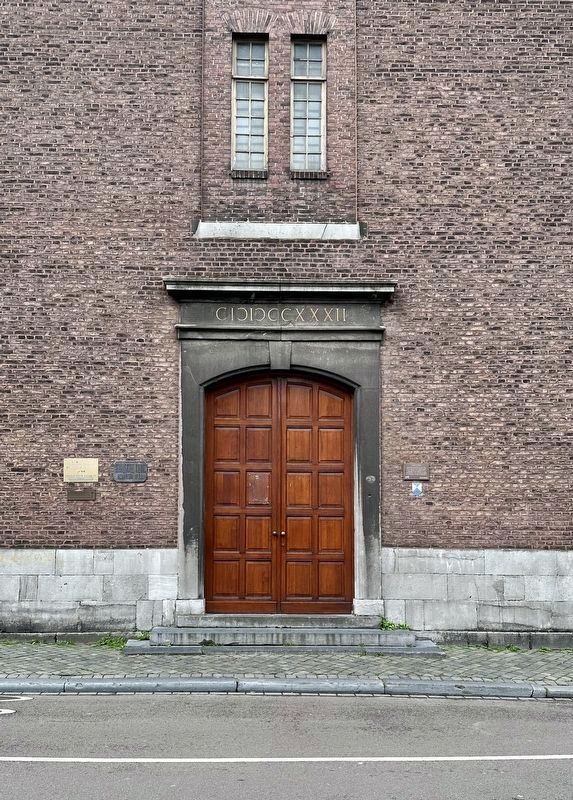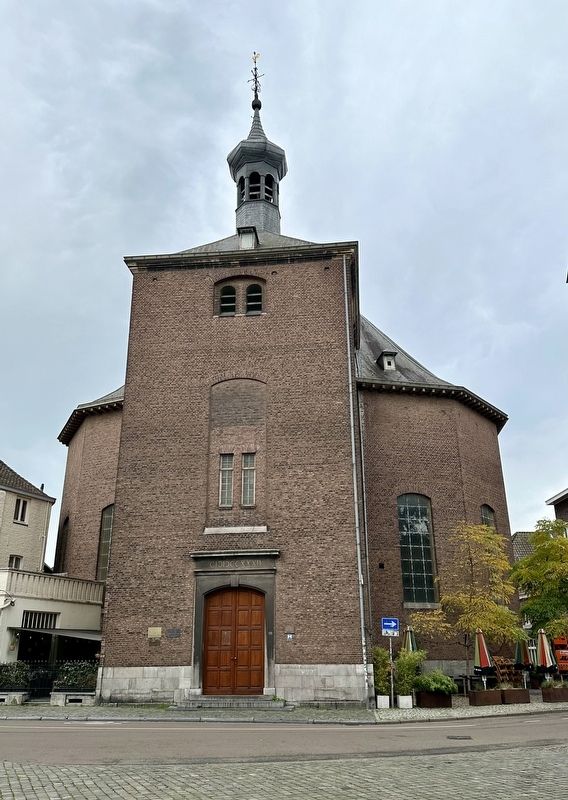Jekerkwartier in Maastricht, Limburg, Netherlands — Northwestern Europe
De Waalse of Franse kerk / The Walloon or French Church
Inscription.
After the conquest of Maastricht by Prince Frederik-Henry in 1632, Protestants were also allowed openly profess their faith. The French Protestants were first allowed to use the Jesuit Church for worship and in 1680 they received the Sint Hillarius Chapel, which was located here on this site. A new church was built in 1732, designed by the Liège architect Nicolas Comhaire, using a dodecagonal central structure.
Erected by ANWB, VVV, Zimmermanfonds.
Topics. This historical marker is listed in these topic lists: Architecture • Churches & Religion. A significant historical year for this entry is 1632.
Location. 50° 50.76′ N, 5° 41.533′ E. Marker is in Maastricht, Limburg. It is in Jekerkwartier. Marker is on Sint Pieterstraat, on the right when traveling south. Touch for map. Marker is at or near this postal address: Sint Pieterstraat 6, Maastricht, Limburg 6211 JN, Netherlands. Touch for directions.
Other nearby markers. At least 8 other markers are within walking distance of this marker. Franciscanen- of Minderbroederskerk / Franciscan or “Little Brothers” Church (within shouting distance of this marker); Eerste Stadsommuring / First City Wall (within shouting distance of this marker); Non Sum Qualis Eram (within shouting distance of this marker); De Bisschopsmolen / The Bishop’s Mill (within shouting distance of this marker); Huis de Ridder / House of Ridder (within shouting distance of this marker); Faliezustersklooster / Sisters of the Veil Convent (about 90 meters away, measured in a direct line); Stadsommuring / City Walls (about 120 meters away); Waterpoort Achter de Minderbroeders / “Behind the Franciscans” Water Gate (about 120 meters away). Touch for a list and map of all markers in Maastricht.
Also see . . . Waalse kerk (Maastricht) (Wikipedia, in Dutch).
Excerpt: After the conquest of Maastricht by Frederik Hendrik, Maastricht exerted a certain attraction on Walloon followers of Calvinism, who fled the Catholic Prince-Bishopric of Liège. According to the capitulation conditions(Submitted on November 8, 2023.)of 1632, the French-speaking Protestants were allowed to openly practice their faith in Maastricht and were given access to the St. Hilary Chapel, a former district or kerspel chapel of the Our Lady parish. The first preacher was Samuel Maresius, house preacher and protégé of the first State governor of Maastricht, the Duke of Bouillon. After the Betrayal of Maastricht (1638), the Walloon church (Église wallonne reformée) moved to the Jesuit church (nowadays Bonbonnière). When the Jesuits were allowed to return to the city during the French occupation (1673-1678), the Walloon congregation first moved to the St. Catherine's Chapel on Boschstraat, eventually returning to the St. Hilary Chapel in 1680.
In 1685, Protestants in France lost their rights with the Edict of Fontainebleau, causing tens of thousands of Huguenots to flee to the Calvinist Republic of the Seven United Netherlands. The Maastricht Walloon community also grew strongly (especially due to refugees from Sedan), making the St. Hilary Chapel too small. The medieval chapel was enlarged (or replaced by a new church) in 1686. The renovated chapel was demolished in 1732 to make way for the current church, designed by the Liège architect Nicolas Comhaire. The new church was partly built above the Jeker river. The construction time was 22 months. The dedication took place on December 6, 1733.
Credits. This page was last revised on December 31, 2023. It was originally submitted on November 8, 2023, by Andrew Ruppenstein of Lamorinda, California. This page has been viewed 51 times since then and 17 times this year. Photos: 1, 2, 3. submitted on November 8, 2023, by Andrew Ruppenstein of Lamorinda, California.


